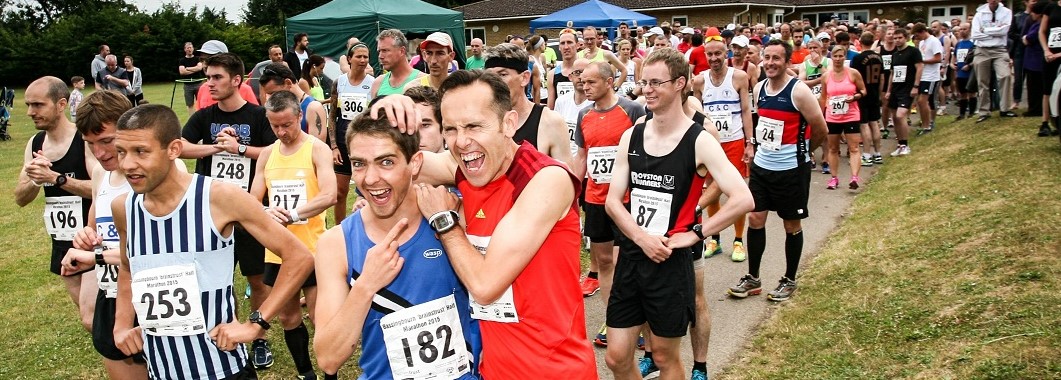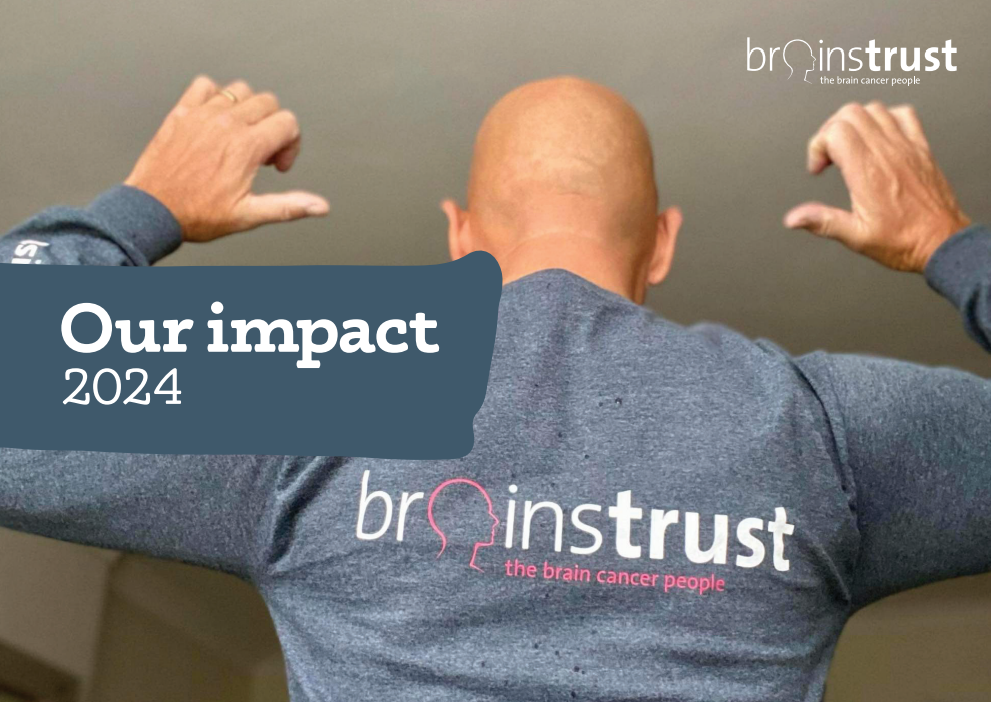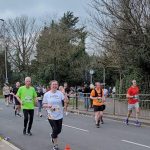
brainstrust Bass Belle 10k 2025 entry list
Race registrations
The registration list is updated twice weekly.Click here to go back to the event home page.
| 1 | Ciara | Mole | |||||||||||||
|---|---|---|---|---|---|---|---|---|---|---|---|---|---|---|---|
| 2 | Garry | Bygrave | |||||||||||||
| 3 | Zoe | Robinson | Royston Runners | ||||||||||||
| 4 | Feridun | Kadir | Bishops Stortford Running Club | ||||||||||||
| 5 | David | Cran | |||||||||||||
| 6 | Amy | Kingdon | |||||||||||||
| 7 | Lynn | Roberts | Cambridge & Coleridge AC | ||||||||||||
| 8 | Tamsin | Cromwell | Royston Runners | ||||||||||||
| 9 | Gemma | Stanford | |||||||||||||
| 10 | Monica | Smithson | Fairlands Valley Spartans | ||||||||||||
| 11 | Naomi | Levy | |||||||||||||
| 12 | Gareth | Bradford | |||||||||||||
| 13 | Michelle | Hawker | Royston Runners | ||||||||||||
| 14 | Fiona | Swancott | Royston Runners | ||||||||||||
| 15 | Jenny | Klaassen | Royston Runners | ||||||||||||
| 16 | Chris | Morgan | |||||||||||||
| 17 | Phil | Seddon | |||||||||||||
| 18 | Sara | McGowan | Royston Runners | ||||||||||||
| 19 | Elizabeth | Walker | Royston Runners | ||||||||||||
| 20 | Nicola | Ashman | Royston Runners | ||||||||||||
| 21 | Eris | Duro | |||||||||||||
| 22 | Maria | Spinetta | |||||||||||||
| 23 | Emma | Bullers | |||||||||||||
| 24 | Joanne | Capewell | |||||||||||||
| 25 | Paul | Phillips | |||||||||||||
| 26 | Julie | Wiseman | Royston Runners | ||||||||||||
| 27 | Elizabeth | Underwood | |||||||||||||
| 28 | John | Sunerton | Royston Runners | ||||||||||||
| 29 | Trudi | Morrish | |||||||||||||
| 30 | Shirley | Fowler | Haverhill Running Club | ||||||||||||
| 31 | Claire | Rooney | Saffron Striders Running Club | ||||||||||||
| 32 | Lyn | Hudson | Saffron Striders Running Club | ||||||||||||
| 33 | Anouska | Cotton | |||||||||||||
| 34 | Jon | Norton | |||||||||||||
| 35 | Claire | Grimmer | |||||||||||||
| 36 | Nick | Wainwright | |||||||||||||
| 37 | Laura | Briggs | |||||||||||||
| 38 | Jake | Sarter | |||||||||||||
| 39 | Charlie | Day | |||||||||||||
| 40 | Adam | Mitchell | |||||||||||||
| 41 | Ian | Oliver | |||||||||||||
| 42 | Kate | French | |||||||||||||
| 43 | Alison | Wilkinson | Shefford Runners | ||||||||||||
| 44 | Matthew | Stanford | |||||||||||||
| 45 | Stuart | Ray | ROCStars | ||||||||||||
| 46 | Stephen | Fleming | Cambridge & Coleridge AC | ||||||||||||
| 47 | Martyn | Brearley | Cambridge & Coleridge AC | ||||||||||||
| 48 | Alex | Geoghegan | Cambridge & Coleridge AC | ||||||||||||
| 49 | Charlie | Bryan | |||||||||||||
| 50 | Becci | Chandler | |||||||||||||
| 51 | Vicky | Clifton – Oliver | |||||||||||||
| 52 | Dan | Allison | |||||||||||||
| 53 | Finn | McCormick | |||||||||||||
| 54 | Will | Boyd | |||||||||||||
| 55 | Andrew | Farmery | Bishops Stortford Running Club | ||||||||||||
| 56 | Graham | Boswell | |||||||||||||
| 57 | Cheryl | Boswell | |||||||||||||
| 58 | Dawn | Feasey | |||||||||||||
| 59 | Chris | Button | North Herts Road Runners | ||||||||||||
| 60 | Eloise | Button | |||||||||||||
| 61 | Izzy | Holcroft | |||||||||||||
| 62 | Taylor | Hart | |||||||||||||
| 63 | Steph | Clouston | Thetford Rc | ||||||||||||
| 64 | Lisa | Hazell | Pottsands | ||||||||||||
| 65 | Bode | Hazell | Pottsands | ||||||||||||
| 66 | Chris | Hazell | Pottsands | ||||||||||||
| 67 | Erika | Bosman | |||||||||||||
| 68 | Dave | Carter | |||||||||||||
| 69 | Kevin | Foskett | Royston Runners | ||||||||||||
| 70 | Arran | Grimes | |||||||||||||
| 71 | Fleur | Bevan | |||||||||||||
| 72 | Hannah | Prince | Bishops Stortford Running Club | ||||||||||||
| 73 | Kara | Hayhurst | |||||||||||||
| 74 | Jenny | Wilson | |||||||||||||
| 75 | Brad | Calvert | Royston Runners | ||||||||||||
| 76 | Paul | Morrison | Bishops Stortford Running Club | ||||||||||||
| 77 | Paul | Evans | Royston Runners | ||||||||||||
| 78 | James | Dalton | North Herts Road Runners | ||||||||||||
| 79 | Cathy | Chin | |||||||||||||
| 80 | Amy | Stanford | |||||||||||||
| 81 | Tony | Pyle | |||||||||||||
| 82 | Johannah | Hickton | Bedford Harriers AC | ||||||||||||
| 83 | Bryan | Young | |||||||||||||
| 84 | Alison | Stewart | Huntingdonshire AC | ||||||||||||
| 85 | Julian | Bedford | |||||||||||||
| 86 | Gemma | Bedford | Huntingdonshire AC | ||||||||||||
| 87 | Andy | Nightingale | |||||||||||||
| 88 | James | Sankey | |||||||||||||
| 89 | Ailsa | Heal | |||||||||||||
| 90 | Murray | Heal | North Stevenage | ||||||||||||
| 91 | Arran | Heal | Royston Runners | ||||||||||||
| 92 | Niranjala | Button | |||||||||||||
| 93 | Sam | Cooper | |||||||||||||
| 94 | Thomas | Mallindine | |||||||||||||
| 95 | Rebecca | Mallindine | |||||||||||||
| 96 | Phil | Coombes | Stotfold Runners | ||||||||||||
| 97 | Callie | Chapman | Fairlands Valley Spartans | ||||||||||||
| 98 | Daniel | Strzelecki | |||||||||||||
| 99 | Hazel | Smith | Fairlands Valley Spartans | ||||||||||||
| 100 | Emily | Symington | |||||||||||||
| 101 | Kate | McAuliffe | Royston Runners | ||||||||||||
| 102 | Fergus | McAuliffe | Royston Runners | ||||||||||||
| 103 | Emma | Cowper | Bishops Stortford Running Club | ||||||||||||
| 104 | Linda | Jean Parcell | |||||||||||||
| 105 | Gary | Smith | |||||||||||||
| 106 | Naomi | Davies | |||||||||||||
| 107 | Dawn | Abbatt | |||||||||||||
| 108 | Katherine | Scheepers | |||||||||||||
| 109 | Hayley | Walker Smith | |||||||||||||
| 110 | Rebecca | Taylor | |||||||||||||
| 111 | Alan | Symington | |||||||||||||
| 112 | Angie | Sleat | |||||||||||||
| 113 | Carrie | Taylor | |||||||||||||
| 114 | Laura | Herd | Royston Runners | ||||||||||||
| 115 | Jordan | Herd | Royston Runners | ||||||||||||
| 116 | Robin | Brouard | |||||||||||||
| 117 | |||||||||||||||
| 118 | Mike | Phillips | North Herts Road Runners | ||||||||||||
| 119 | Carrie | Fung | |||||||||||||
| 120 | Mia | Lloyd | |||||||||||||
| 121 | Adam | Day | |||||||||||||
| 122 | Lucy | Ireland | |||||||||||||
| 123 | Charlotte | Kill | |||||||||||||
| 124 | Kylie | Prankerd | Deepdale Doggers | ||||||||||||
| 125 | Stephanie | Crotty | Royston Runner | ||||||||||||
| 126 | Rowena | Moore | |||||||||||||
| 127 | Nick | Buckle | RAFAC | ||||||||||||
| 128 | Georgina | Thorpe | REC Runners | ||||||||||||
| 129 | Nick | Bramwell | |||||||||||||
| 130 | Claire | Burke | |||||||||||||
| 131 | Conrad | Wellstead | |||||||||||||
| 132 | Rebecca | Rayner | Fairlands Valley Spartans | ||||||||||||
| 133 | Sally | Pickles | Fairlands Valley Spartans | ||||||||||||
| 134 | Megan | Sutton | Fairlands Valley Spartans | ||||||||||||
| 135 | Samantha | Sutton | Fairlands Valley Spartans | ||||||||||||
| 136 | Colm | Reddington | |||||||||||||
| 137 | Carla | Kay | Royston Runners | ||||||||||||
| 138 | Sarah | Wells | Park Fitness Royston | ||||||||||||
| 139 | Sue | O’Farrell | Royston Runners | ||||||||||||
| 140 | Gillian | Martin | |||||||||||||
| 141 | Natalie | Phillips | North Herts Road Runners | ||||||||||||
| 142 | Adam | Knaggs | BRJ Run & Tri | ||||||||||||
| 143 | Karen | Knaggs | BRJ Run & Tri | ||||||||||||
| 144 | Andy | Denyer | |||||||||||||
| 145 | Graham | Broughton | |||||||||||||
| 146 | Mali | Storan | Cambridge & Coleridge AC | ||||||||||||
| 147 | Caspar | Alliott | |||||||||||||
| 148 | Chris | Alliott | |||||||||||||
| 149 | Alexander | Nelson | Cambridge & Coleridge AC | ||||||||||||
| 150 | Joseph | Mullen | |||||||||||||
| 151 | Tom | Mullen | |||||||||||||
| 152 | Kevin | Ryan | BRJ Run & Tri | ||||||||||||
| 153 | Matthew | Hockley | Royston Runners | ||||||||||||
| 154 | Terry | Kay | |||||||||||||
| 155 | Zoe | Dickinson | |||||||||||||
| 156 | Siobhan | Palmer | Hitchin Running Club | ||||||||||||
| 157 | Nicole | Hearne | |||||||||||||
| 158 | Max | Lian | |||||||||||||
| 159 | Ollie | Thorne | Papworth Runners | ||||||||||||
| 160 | Sally | Fairclough | |||||||||||||
| 161 | Richard | Cooke | |||||||||||||
| 162 | Karyna | Manuel | |||||||||||||
| 163 | Donna | Manuel | |||||||||||||
| 164 | Lucy | Robertson | North Herts Road Runners | ||||||||||||
| 165 | Charlie | Heaford | |||||||||||||
| 166 | Faye | Finch | |||||||||||||
| 167 | Emma | Hodson | Cambridge University Hare & Hounds | ||||||||||||
| 168 | Joe | Watts | Royston Runners | ||||||||||||
| 169 | Rose | Sutton | Fairlands Valley Spartans | ||||||||||||
| 170 | Cameron | Burton | |||||||||||||
| 171 | Lucy | Thomas | |||||||||||||
| 172 | Tyreece | Lawrence | |||||||||||||
| 173 | Willem | Mason Geraghty | |||||||||||||
| 174 | Scott | Boseley | |||||||||||||
| 175 | Helen | Fernandes | |||||||||||||
| 176 | Helen | Hinchliffe | |||||||||||||
| 177 | Kim | Collen | |||||||||||||
| 178 | Thomas | Wales | |||||||||||||
| 179 | Daniel | Kirby | |||||||||||||
| 180 | Tiger | Smith | |||||||||||||
| 181 | Daniel | Smith | |||||||||||||
| 182 | Maddison | Rowe | |||||||||||||
| 183 | James | Boar | |||||||||||||
| 184 | William | Reavell | WAOC | ||||||||||||
| 185 | Kingsley | Reavell | WAOC | ||||||||||||
| 186 | Sophie | Johnston | |||||||||||||
| 187 | John | Harris | Fairlands Valley Spartans | ||||||||||||
| 188 | Danny | Brown | |||||||||||||
| 189 | Chris | O’Connor | |||||||||||||
| 190 | Kerrie | Bulcock | |||||||||||||
| 191 | Laura | Page | |||||||||||||
| 192 | Ed | Whybrow | Meridian Tri | ||||||||||||
| 193 | David | Overton | Stevenage Striders | ||||||||||||
| 194 | Chloe | Chambers | |||||||||||||
| 195 | Alison | Everington | |||||||||||||
| 196 | Matt | Underwood | |||||||||||||
| 197 | Emer | McAuliffe | |||||||||||||
| 198 | Rory | McAuliffe | |||||||||||||
| 199 | Clare | Whybrow | Royston Runners | ||||||||||||
| 200 | Richard | Stevens | BRJ Run & Tri | ||||||||||||
| 201 | Eszter | Csomor | Meridian Tri Club | ||||||||||||
| 202 | Rico | Hilliard | |||||||||||||
| 203 | Tracey | McCreath | North Herts Road Runners | ||||||||||||
| 204 | Tina | Filby | Meridian Tri Club | ||||||||||||
| 205 | Tina | Smith | |||||||||||||
| 206 | Sophie | Allen | |||||||||||||
| 207 | Connor | Robinson | |||||||||||||
| 208 | Heidi | Clark | |||||||||||||
| 209 | Greg | Barker | REC Runners | ||||||||||||
| 210 | Archie | Gilbey | Royston Runners | ||||||||||||
| 211 | Simon | Mitchell | |||||||||||||
| 212 | Beth | Thompson | |||||||||||||
| 213 | Clare | Jenkins | St Neots Riverside Runners | ||||||||||||
| 214 | Sophia | Smith | Wimpole Runners | ||||||||||||
| 215 | Brian | Jones | Royston Runners | ||||||||||||
| 216 | Clare | Thurgood | Cambridge & Coleridge AC | ||||||||||||
| 217 | Findlay | Livingstone | |||||||||||||
| 218 | Giuseppe | Guarino | |||||||||||||
| 219 | Jon | Kingdon | |||||||||||||
| 220 | Siobhan | Randall | Nuffield | ||||||||||||
| 221 | Claire | Thomas | Pottsands | ||||||||||||
| 222 | Cheryl | Trundle | Haverhill Running Club | ||||||||||||
| 223 | Paul | Roberts | Newmarket Joggers | ||||||||||||
| 224 | Vera | Shevchenko | Mikkeller Club | ||||||||||||
| 225 | Isobel | Dix | |||||||||||||
| 226 | Matthew | Lynn | |||||||||||||
| 227 | Peter | Ryan | |||||||||||||
| 228 | Matthew | Baxter | |||||||||||||
| 229 | Lucille | Froggett | |||||||||||||
| 230 | Stephen | Rudolf | |||||||||||||
| 231 | Sarah | Williams | |||||||||||||
| 232 | Harry | Winterford | |||||||||||||
| 233 | Lauren | Reilly | Royston Runners | ||||||||||||
| 234 | Adam | Murphy | Pottsands | ||||||||||||
| 235 | Sam | McKenzie | |||||||||||||
| 236 | Sam | Rice | |||||||||||||
| 237 | Pippa | Kidd | |||||||||||||
| 238 | Kathryn | Hunt | |||||||||||||
| 239 | Connor | Smith | |||||||||||||
| 240 | Martin | Kingsley | |||||||||||||
| 241 | Joanne | Roberts | |||||||||||||
| 242 | Richard | Bray | |||||||||||||
| 243 | Emma | Dix | |||||||||||||
| 244 | Sil | Clay | Haverhill Running Club | ||||||||||||
| 245 | James | Worrall | |||||||||||||
| 246 | Katie | Seymour | |||||||||||||
| 247 | Yumiko | Carter | |||||||||||||
| 248 | Michelle | Lucy | |||||||||||||
| 249 | Stephen | Collins | |||||||||||||
| 250 | Edward | Banham – Hall | Cambridge & Coleridge AC | ||||||||||||
| 251 | Alan | Oliver | Hitchin Running Club | ||||||||||||
| 252 | Matt | Fowler | |||||||||||||
| 253 | Ryan | Wakefield | Cambridge & Coleridge AC | ||||||||||||
| 254 | Alison | Roberts | Royston Runners | ||||||||||||
| 255 | Richard | Moloney | |||||||||||||
| 256 | Alice | Kendrick | |||||||||||||
| 257 | Edward | Kendrick | Stevenage & North Herts Athletics Club | ||||||||||||
| 258 | David | Lamb | |||||||||||||
| 259 | Carrie | Evans | |||||||||||||
| 260 | Kayleigh | Williams | Royston Runners | ||||||||||||
| 261 | Isobel | Rawlinson | |||||||||||||
| 262 | Emily | King | |||||||||||||
| 263 | Brian | Corleys | Bushfield Joggers | ||||||||||||
| 264 | Alex | Thompson | Saffron Striders Running Club | ||||||||||||
| 265 | James | Stewart | |||||||||||||
| 266 | Lucy | Carey | Hitchin Running Club | ||||||||||||
| 267 | Hannah | Stephenson | Steeple Chasers | ||||||||||||
| 268 | Daniela | Attenborough | |||||||||||||
| 269 | Eleanor | Thompson | |||||||||||||
| 270 | Jennifer | Thorn | |||||||||||||
| 271 | Patti | Rio – Green | |||||||||||||
| 272 | Sam | Richardson | Serpentine Running Club | ||||||||||||
| 273 | Neil | Whitaker | BRJ Run & Tri | ||||||||||||
| 274 | Donna | Whitaker | BRJ Run & Tri | ||||||||||||
| 275 | David | Chalcraft | |||||||||||||
| 276 | Charles | Hall | |||||||||||||
| 277 | David | Collinge | |||||||||||||
| 278 | Carina | Quayle | North Herts Road Runners | ||||||||||||
| 279 | Jane | O’Callaghan | Royston Runners | ||||||||||||
| 280 | Chris | Hoare | Bedford Harriers AC | ||||||||||||
| 281 | Gail | Cartmell | Meridan Tri Club | ||||||||||||
| 282 | Robert | Shaw | Saffron Striders Running Club | ||||||||||||
| 283 | Tre | Moulton | |||||||||||||
| 284 | Alexandra | Picton | |||||||||||||
| 285 | Joseph | Philip | Cambridge & Coleridge Athletics Club | ||||||||||||
| 286 | Darragh | O’Reilly | |||||||||||||
| 287 | Arina | Machine | |||||||||||||
| 288 | Chris | Curson | Shefford Runners | ||||||||||||
| 289 | Harriet | Tilney | |||||||||||||
| 290 | Angela | Baulk | Royston Runners | ||||||||||||
| 291 | Tina | Lamb | Royston Runners | ||||||||||||
| 292 | Lee | Roberts | Royston Runners | ||||||||||||
| 293 | Allesio | Li Volsi | |||||||||||||
| 294 | Kate | Ware | |||||||||||||
| 295 | Liz | Anderson | Stotfold Runners | ||||||||||||
| 296 | Sarah | Chalmers | Stotfold Runners | ||||||||||||
| 297 | Billy | Baulk | |||||||||||||
| 298 | Gio | Tamburello | Royston Runners | ||||||||||||
| 299 | Helena | Campos | |||||||||||||
| 300 | Paul | Jones | Lonely Goat Running Club | ||||||||||||
| 301 | Martin | Amos | Huntingdonshire AC | ||||||||||||
| 302 | Indigo | Luksch | Team Trinity | ||||||||||||
| 303 | Nathaniel | Chance | Team Runners Up | ||||||||||||
| 304 | Leo | Liu | Team Trinity | ||||||||||||
| 305 | Nial | Tanver | |||||||||||||
| 306 | Joseph | Lambert | |||||||||||||
| 307 | Nigel | Blake | Deepdale Doggers | ||||||||||||
| 308 | Cheryl | Barsdell | Shefford Runners | ||||||||||||
| 309 | Alex | Overton | Stevenage Striders | ||||||||||||
| 310 | Robyn | Childs | Royston Runners | ||||||||||||
| 311 | Alan | Hopkins | Stotfold Runners | ||||||||||||
| 312 | Sarah | Brigden | Stotfold Runners | ||||||||||||
| 313 | Dan | Wehrli | |||||||||||||
| 314 | Martin | Wheatley | |||||||||||||
| 315 | Thea | Wheatley | |||||||||||||
| 316 | Amy | Matthews | Stotfold Runners | ||||||||||||
| 317 | Richard | Davies | |||||||||||||
| 318 | Alex | Smart | BRJ Run & Tri | ||||||||||||
| 319 | Anna | Klucnika | Speya Running | ||||||||||||
| 320 | Benjamin | Mohankumar | Speya Running | ||||||||||||
| 321 | Sara | Morrison | |||||||||||||
| 322 | Phil | Martin | Royston Runners | ||||||||||||









